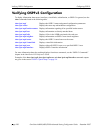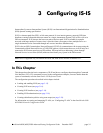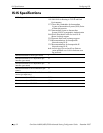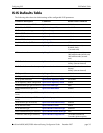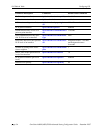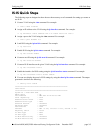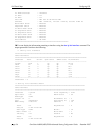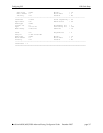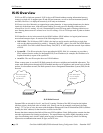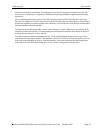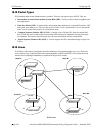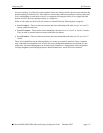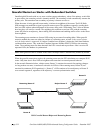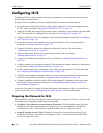
IS-IS Overview Configuring IS-IS
page 3-8 OmniSwitch 6800/6850/9000 Advanced Routing Configuration Guide December 2007
IS-IS Overview
IS-IS is an SPF or link state protocol. IS-IS is also an IGP that distributes routing information between
routers in a single AS. It supports pure IP and OSI environments, as well as dual environments (both IP
and OSI). However, it is deployed extensively in IP-only environments.
IS-IS uses a two-level hierarchy to support large routing domains. A large routing domain may be admin-
istratively divided into areas, with each router residing in exactly one area. Routing within an area is
referred to as Level-1 routing. A Level-1 Intermediate System (IS) keeps track of routing within its own
area. Routing between areas is referred to as Level-2 routing. A Level-2 IS keeps track of paths to destina-
tion areas.
IS-IS identifies a device in the network by the NSAP address. NSAP address is a logical point between
network and transport layers. It consists of the following three fields:
• NSEL field—The N-Selector (NSEL) field is the last byte and it must be specified as a single byte
with two hex digits preceded by a period (.). Normally, the NSEL value is set to 00.The NSAP address
with its NSEL set to 00 is called Network Entity Title (NET). A NET implies the network layer address
of IS-IS.
• System ID— This ID occupies the 6 bytes preceding the NSEL field. It is customary to use either a
MAC address from the router (for Integrated IS-IS) or an IP address (for example, the IP address of a
loopback interface) as part of the system ID.
• Area ID—The area ID occupies the rest of NSAP address.
When a router starts, it uses the IS-IS Hello protocol to discover neighbors and establish adjacencies. The
router sends Hello packets through all IS-IS-enabled interfaces to its neighbors, and in turn receives Hello
packets. In a broadcast network, the Hello protocol elects a Designated Intermediate System (DIS) for the
network.
IS-IS Hello Protocol
Separate DISs are elected for Level-1 and Level-2 routing. Election of the DIS is based on the highest
interface priority, the default value of which is 64. Priority can also be manually configured, the range
being 1–127. In case of a tie, the router with the highest Subnetwork Point Of Attachment (SNPA) address
(usually the MAC address) for that interface is elected as the DIS.
Routers that share common data links will become IS-IS neighbors if their Hello packets contain data that
meet the requirements for forming an adjacency. The requirements may differ slightly depending on the
type of media being used, which is either point-to-point or broadcast. The primary criteria for forming
adjacencies are authentication match, IS-type, and MTU size.
Hello. Please respond...
Are you a neighbor...
Hello. Please respond...
Are you a neighbor...
My link state is...
My link state is...



